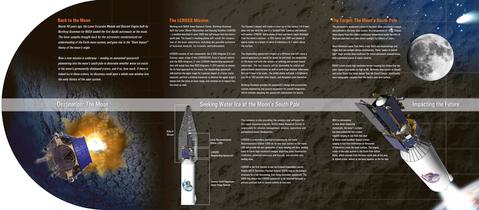
Catalog excerpts

Lunar CRater Observation and Sensing Satellite NASA’s Return to the Moon LCROSS Instruments and Technical Information LCROSS The Goal: Water Ice In 1998, NASA’s Lunar Prospector mission detected hydrogen near the surface in permanently shadowed craters at the lunar poles. The most likely explanation for the hydrogen is water ice – the primary goal of the LCROSS mission is to test this hypothesis. But how did it get there? When a comet hits the moon, it deposits water vapor and ice on the surface. During the hot lunar day, any deposited water boils off to join the moon’s tenuous atmosphere and might be ionized by radiation and carried off into space. During the lunar night, any leftover water falls back to the surface, potentially far from the initial cometary impact. If water manages to fall into a permanently shadowed crater, it will be caught in the so-called “cold trap.” These cold traps have existed for billions of years and have been gathering water, molecule by molecule, all that time. Information for Observation of LCROSS Impact The general public, classrooms, and the astronomy community can check the following site for the latest specific information on how and exactly when to observe the impact as the mission progresses: http://www.nasa.gov/lcross The plume will be very bright (approximately 5th magnitude) and should be visible with telescopes greater than 10” in diameter. The most favorable Earth-based observing locations include Hawaii and the western U.S. In addition to the United States’ Lunar Reconnaissance Orbiter, we are working to have the Hubble Space Telescope observe the impact. Numerous ground-based observatories also will be observing the impact. NASA has dedicated the LCROSS mission to the memory of legendary news anchor, Walter Cronkite, who covered NASA’s missions from the beginning of America’s manned space program to the age of the space shuttle. Mission LCROSS Description The mission objective of the Lunar Crater Observation and Sensing Satellite is to confirm the presence or absence of water ice in a permanently shadowed crater at the moon’s south pole. Science Instruments • 5 Cameras (1 visible, 2 Near IR, 2 Mid IR) • 3 Spectrometers (1 visible, 2 Near IR) • 1 Photometer Principal Investigator Dr. Anthony Colaprete (NASA Ames Research Center) Launch Vehicle Atlas V 401 Launch Site Cape Canaveral Air Force Station, Launch Complex 41 Launch Date June 18, 2009 Impact Date and Time Oct. 9, 2009; 4:30 a.m. PDT Impact Crater Cabeus A Time between Centaur impact and shepherding 4 minutes of observations and real-time transmission spacecraft impact from shepherding spacecraft Impact speed 2.5 km/s (5,600 mph) Time from program start to spacecraft completion 27 months Mission Quick Facts ©2009 Northrop Grumman Corporation • All Rights Reserved • Printed in USA • Aerospace Systems Marketing Communications • 99K7AA/STX91KA2G • 1,200 • SL • 06/09
Open the catalog to page 1
Nearly 40 years ago, the Lunar Excursion Module and Descent Engine built by Northrop Grumman for NASA landed the first Apollo astronauts on the moon. The lunar samples brought back by the astronauts revolutionized our understanding of the Earth-moon system, and gave rise to the “Giant Impact” theory of the moon’s origin. Now a new mission is underway – sending an unmanned spacecraft plummeting into the moon’s south pole to determine whether water ice exists in the moon’s permanently shadowed craters, and if so, how much. If there is indeed ice in these craters, its discovery could open a...
Open the catalog to page 2All Northrop Grumman SYNOPTICS catalogs and technical brochures
-
Air Spaced Polarizer
2 Pages
-
Ruby ? Cr3+: Al2O3
2 Pages
-
Alexandrite
2 Pages
-
Contract Crystal Growth
1 Pages
-
Chandra X-Ray Observatory
2 Pages
-
Advanced EHF Payloads (AEHF)
2 Pages
-
Fire Scout Navy Brochure
6 Pages
-
MQ-8B Fire Scout
6 Pages
-
B-2 Spirit Bomber
2 Pages
-
X-47B UCAS
2 Pages
-
E-8C
2 Pages
-
E-2D Advanced Hawkeye
6 Pages
-
E-2C Hawkeye 2000
6 Pages































